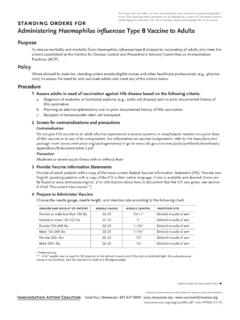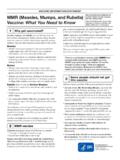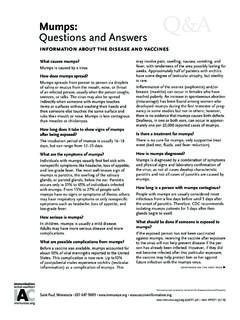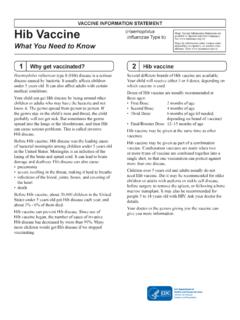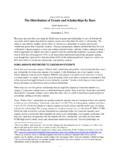Transcription of Diphtheria Q&A Questions and Answers
1 Technical content reviewed by the Centers for Disease Control and PreventionSaint Paul, Minnesota 651-6 47-9009 Item #P4203 (8/18)What causes Diphtheria ? Diphtheria is caused by a bacterium, Corynebacterium diphtheriae. The actual disease is caused when the bacte-ria release a toxin, or poison, into a person's does Diphtheria spread? Diphtheria bacteria live in the mouth, throat, and nose of an infected person and can be passed to others by coughing or sneezing. Occasionally, transmission occurs from skin sores or through articles soiled with oozing from sores of infected long does it take to show signs of Diphtheria after being exposed?The incubation period is short: 2 5 days, with a range of 1 10 are the symptoms of Diphtheria ?Early symptoms of Diphtheria may mimic a cold with a sore throat, mild fever, and chills.
2 Usually, the disease causes a thick coating at the back of the throat, which can make it difficult to breathe or swallow. Other body sites besides the throat can also be affected, including the nose, larynx, eye, vagina, and serious is Diphtheria ? Diphtheria is a serious disease: 5% 10% of all people with Diphtheria die. Up to 20% of cases lead to death in certain age groups of individuals ( , children younger than age 5 years and adults older than age 40 years).What are possible complications from Diphtheria ? most complications of Diphtheria are due to the release of the toxin, or poison. The most common complica-tions are inflammation of the heart leading to abnormal heart rhythms, and inflammation of the nerves which may cause temporary paralysis of some muscles. If the paralysis affects the diaphragm (the major muscle for breathing), the patient may develop pneumonia or respiratory failure.
3 The thick membrane coating at the back of the throat may cause serious breathing prob-lems, including do I know if someone has Diphtheria ?The diagnosis of Diphtheria can only be confirmed after a physician takes a small sample of infected material from the patient's throat (or other site) and has the sample tested in a laboratory. But because this disease progresses quickly, treatment usually should begin based on the health professional's assessment of the there a treatment for Diphtheria ? Diphtheria is treated with both antibiotics and with Diphtheria antitoxin. Diphtheria antitoxin is produced in horses and was first used in the United States in 1891. Antitoxin does not get rid of toxin that is already attached to the body's tissues, but will neutralize any circulating poison and will prevent the disease from getting worse.
4 The patient should be tested for sensi-tivity to this antitoxin before it is common is Diphtheria in the United States? Diphtheria was once a greatly feared illness in the United States. In the 1920s, there were between 100,000 and 200,000 cases of Diphtheria each year with 13,000 15,000 deaths. Because of widespread immu-nization and better living conditions, Diphtheria is now rare in the United States (during 1996 2016, a total of 13 cases of respiratory Diphtheria were reported to CDC). Recent surveys have found that immunity decreases with age, and only 30% of adults age 60 69 years are vaccinated against Diphtheria . This is a concern because the disease continues to occur in other parts of the world. For example, after the breakup of the for-mer Soviet Union, their vaccination rates fell, and large outbreaks of Diphtheria began in 1990 in the Newly Independent States.
5 From 1990 to 1998, more than 150,000 people got sick from Diphtheria and more than 5,000 people died. This situation, and other outbreaks around the world, illustrates what can happen when vaccination levels fall. Outbreaks in other countries also increase the risk of Diphtheria importation into the United and Answersinformation about the disease and vaccinescontinued on the next page Can you get Diphtheria more than once?Yes. Even individuals recovering from Diphtheria should be immunized against the disease as soon as did vaccine first become available for diph-theria, tetanus, and pertussis?The first inactivated toxin, or toxoid, against Diphtheria was developed around 1921, but it was not widely used until the 1930s. In 1924, the first tetanus toxoid (inac-tivated toxin) was produced and was used successfully to prevent tetanus in the armed services during World War II.
6 The first pertussis vaccine was developed in the 1930s and was in widespread use by the mid-1940s, when pertussis vaccine was combined with Diphtheria and tetanus toxoids to make the combination DTP vac-cine. A series of 4 doses of whole-cell DTP vaccine was quite (70 90%) effective in preventing serious pertus-sis disease; however, up to half of the children who received the vaccine developed local reactions such as redness, swelling, and pain at the injection site. In 1991, concerns about safety led to the development of more purified (acellular) pertussis vaccines that are associated with fewer side effects. These acellular per-tussis vaccines have replaced the whole cell DTP vac-cines in the In 2005, two new vaccine products were licensed for use in adolescents and adults that combine the tetanus and Diphtheria toxoids with acellular pertussis (Tdap) vaccine.
7 These vaccines are the first acellular pertussis-containing vaccines that make it possible to vaccinate adolescents and adults against are vaccines made that prevent Diphtheria , tetanus and pertussis?These vaccines are made by chemically treating the Diphtheria , tetanus, and pertussis toxins to render them nontoxic yet still capable of eliciting an immune response in the vaccinated person. They are known as inactivated vaccines because they do not contain live bacteria and cannot replicate themselves, which is why multiple doses are needed to produce s the difference between all the vaccines containing Diphtheria and tetanus toxoids and pertussis vaccine?It s like alphabet soup! Here is a listing of the various products: DTaP: Diphtheria and tetanus toxoids and acellular pertussis vaccine; given to infants and children ages 6 weeks through 6 years.
8 In addition, four childhood combination vaccines include DTaP as a component. DT: Diphtheria and tetanus toxoids, without the pertussis component; given to infants and children ages 6 weeks through 6 years who have a contraindi-cation to the pertussis component. Tdap: Tetanus and Diphtheria toxoids with acellular pertussis vaccine; given to adolescents and adults, usually as a single dose; the exception is pregnant women who should receive Tdap during each preg-nancy. Td: Tetanus and Diphtheria toxoids; given to children and adults ages 7 years and older. Note the small d which indicates a much smaller quantity of Diphtheria toxoid than in the pediatric DTaP are these vaccines given?The DTaP and DT preparations are all given as an injec-tion in the anterolateral thigh muscle (for infants and young toddlers) or in the deltoid muscle (for older chil-dren and adults).
9 Tdap and Td are given in the deltoid muscle for children and adults age 7 years and should get these vaccines?All children, beginning at age 2 months, and adults need protection against these three diseases diphthe-ria, tetanus, and pertussis (whooping cough). Routine booster doses are also needed throughout life. How many doses of vaccine are needed?The usual schedule for infants is a series of four doses of DTaP given at 2, 4, 6, and 15 18 months of age. A fifth shot, or booster dose, is recommended between age 4 and 6 years, unless the fourth dose was given late (after the fourth birthday).For people who were never vaccinated or who may have started but not completed a series of shots, a 3-dose series of Td should be given with 1 to 2 months between dose #1 and #2, and 6 to 12 months between dose #2 and #3.
10 One of the doses, preferably the first, should also contain the pertussis component in the form of Tdap. Because immunity to Diphtheria and tetanus wanes with time, boosters of Td are needed every ten years. Diphtheria : Questions and Answers (continued) page 2 of 4 Immunization Action Coalition Saint Paul, Minnesota 651-6 47-9009 Item #P4203 (8/18)continued on the next page When adolescents and adults are scheduled for their routine tetanus and Diphtheria booster, should they get vaccinated with Td or Tdap?Immunization experts recommend that a dose of Tdap be given to all adolescents at age 11 12 years as a booster during the routine adolescent immunization visit if the adolescent has finished the childhood DTaP schedule and has not already received a dose of Td or Tdap.
